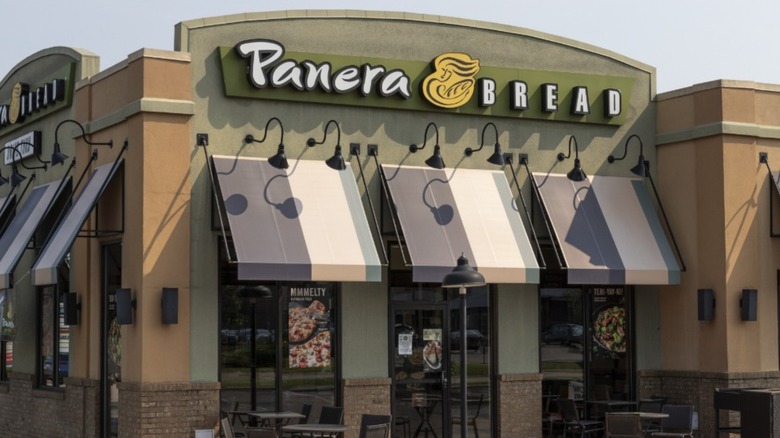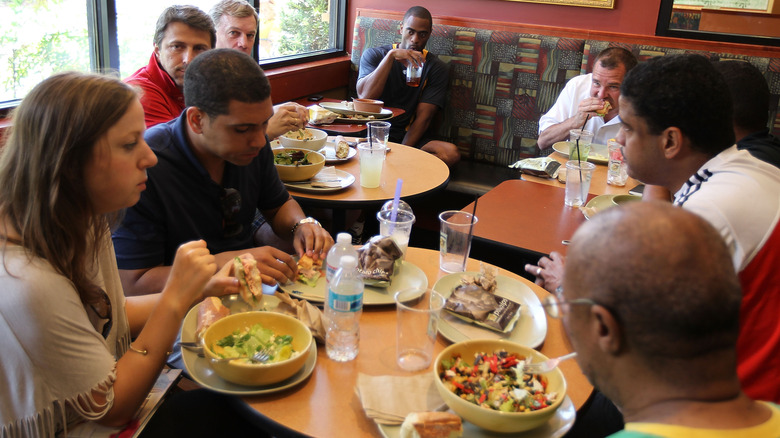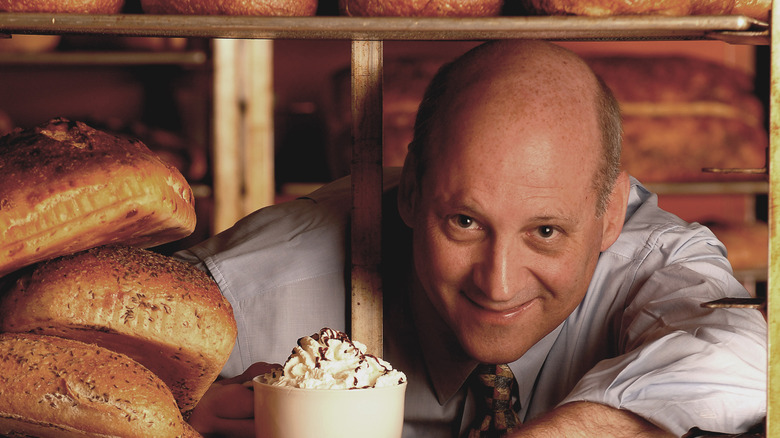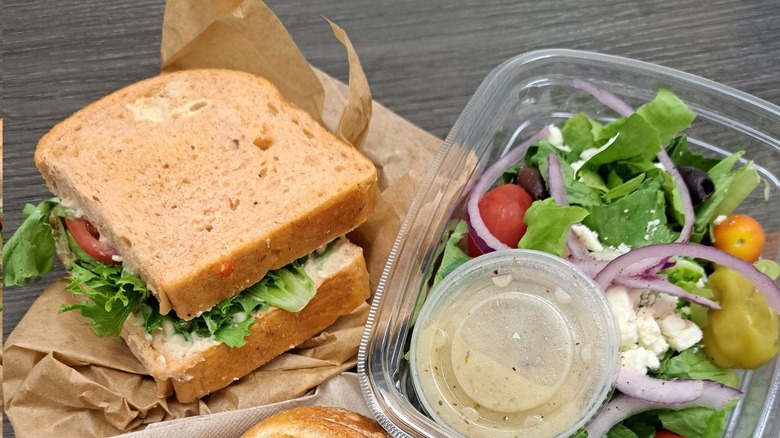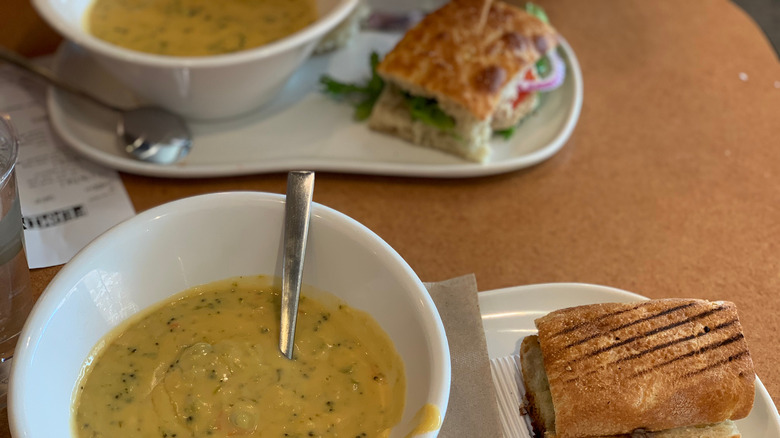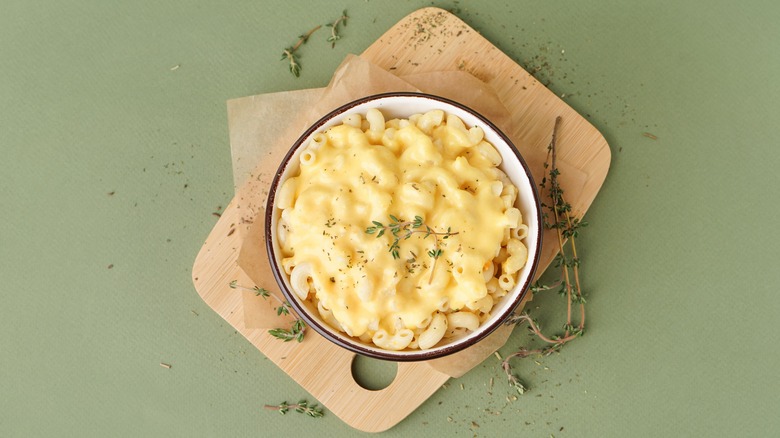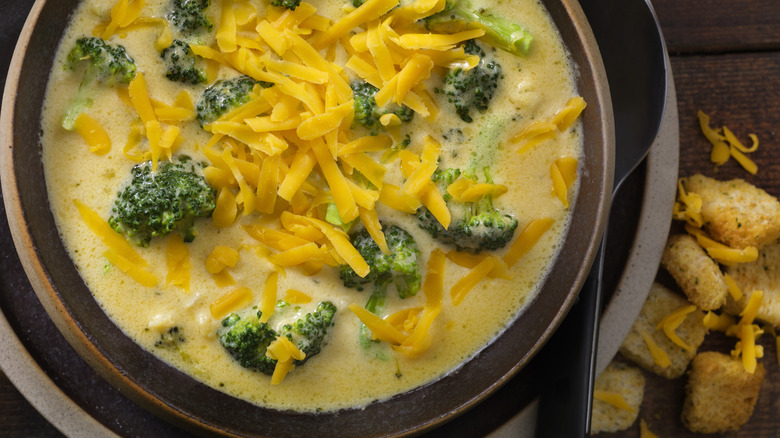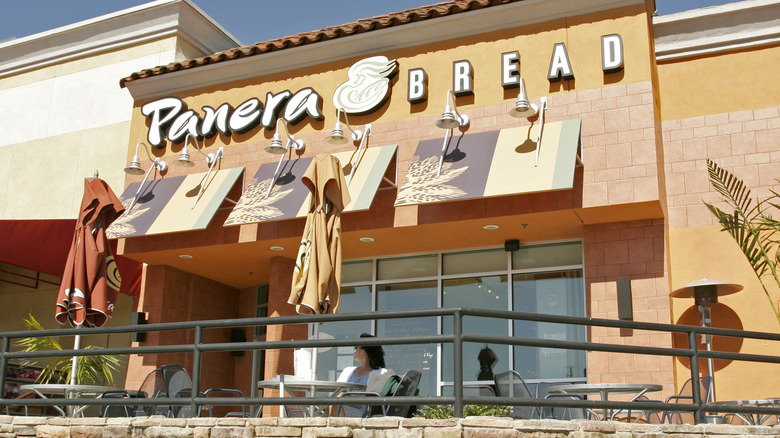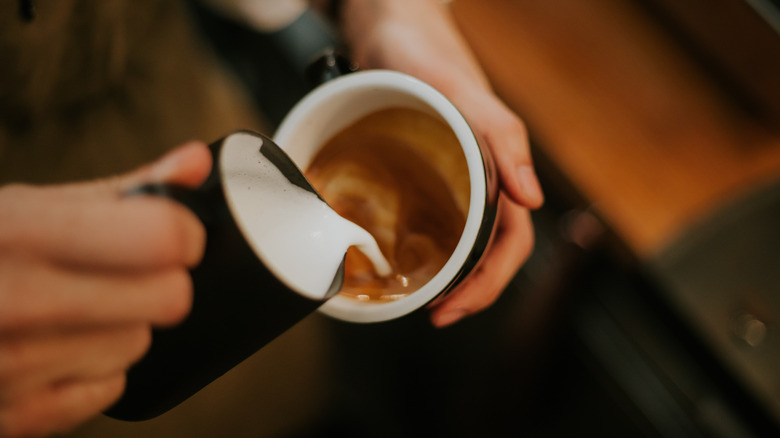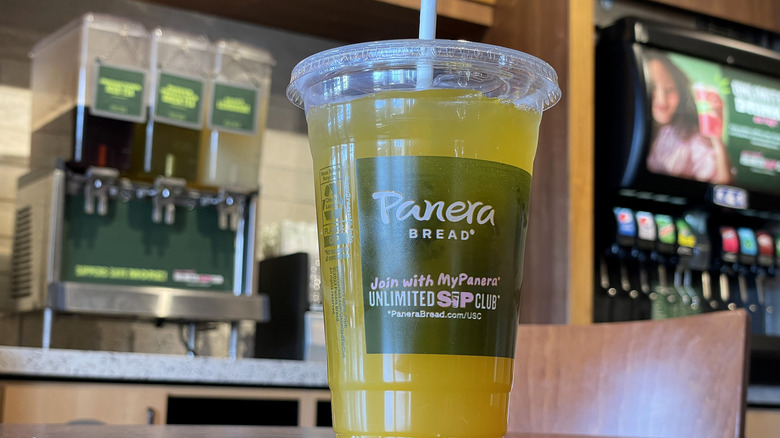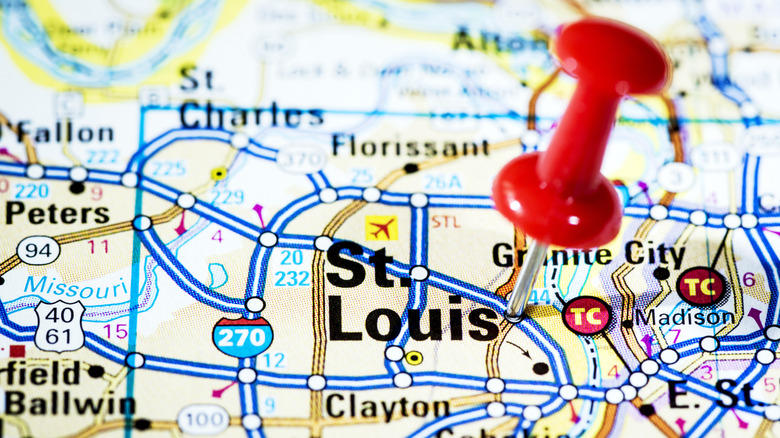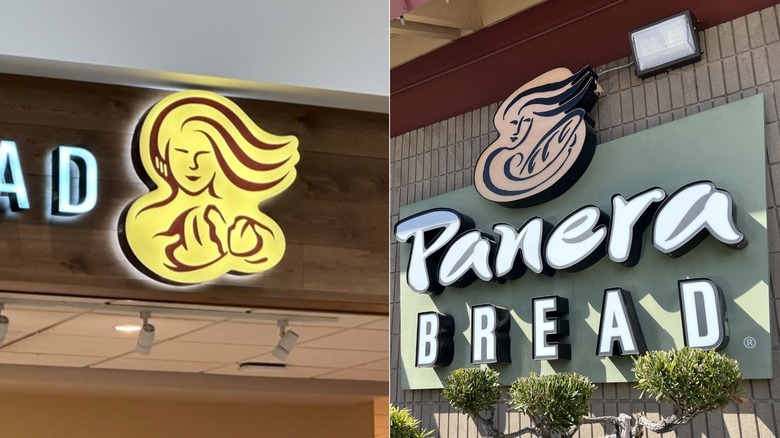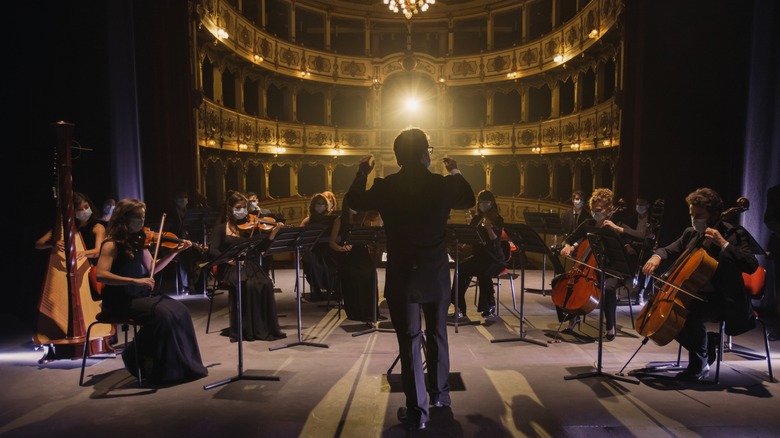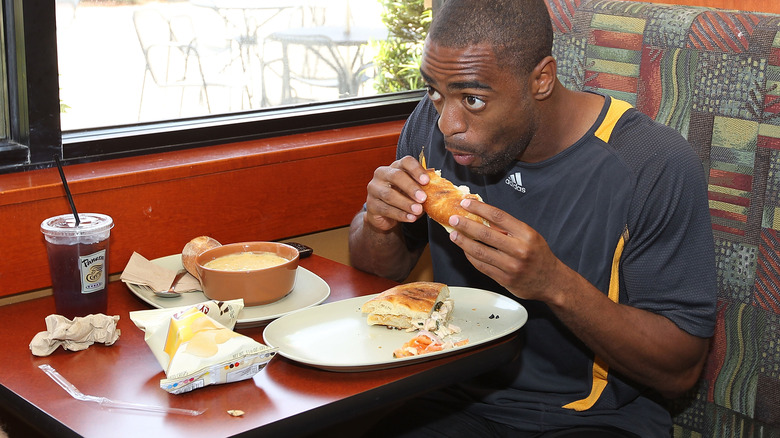The First Ever Panera And What It Was Like To Eat There
In 1987, no one had heard of Panera Bread. The soup and salad staple with famously chill vibes and even more famous mac 'n cheese had just opened, and it was called St. Louis Bread Co. Now, Panera is the place where you can get the perfect balance of half-soup/salad and half-sandwich, but it started from a passion for sourdough.
After Ken Rosenthal visited the European-style bakeries in San Francisco, famous for their sourdough, he came back to Missouri with $150,000 of his own money and an equally-sized small business loan to start his bakery. On the East Coast, other key players in Panera's rise were dipping their toes into bakeries as well. Ron Shaich and Louis Kane would eventually buy the St. Louis Bread Co. in 1993 and turn it into the Panera we know today. At the time, Shaich merged his downtown Boston cookie shop, the Cookie Jar, with Kane's Au Bon Pain and started selling homemade soups and sandwiches made on fresh baguettes.
With an eye toward the future, Shaich and Kane transformed St. Louis Bread Co. into one of the first fast-casual restaurants. As Shaich said to the New Yorker, people wanted food they felt good about. "Basically, they wanted to feel respected by their food," he said. "And what fast food had become was a commodity. It had become nutritional cocaine." Panera began with a mission to give people healthy, clean food and an engaging environment. The same mission prevails across more than 2,000 locations. We don't have a time machine, but we can give you a glimpse into the very first Panera in 1987.
The original Panera wasn't so cozy
Walk into a Panera today and you'll see warm woods and pale green walls, deep oranges and hazy lighting. The overall vibe is cozy, giving the impression of a place you want to dig into and relax. In fact, several people on Reddit have claimed Panera as the best place to do your homework.
But the original St. Louis Bread Co. was very different. Shaich told the Washington Post that the original store had lots of tile, Tiffany lamps, and bread cases everywhere. Based on a YouTube video of a news segment recorded in 1987, the original vibe was far from cozy. Instead, it felt more like a Dunkin' Donuts — somewhere you go to quickly get your bread and head out, not somewhere you'd be happy to hang out for hours. There was very little seating, and what was there were small circular tables and stiff wooden chairs. The lighting felt harsh, and your words would echo against all that tile. Not the Panera we know today.
Panera's sourdough has always come from the same starter
While Panera sells much more than sourdough today, Ken Rosenthal's original starter still has its fingers in all of the sourdough you can buy at Panera stores, according to Panera's history page. The company uses a 36-year-old mother dough originally created from what Rosenthal learned while touring San Franciscan sourdough bakeries.
Also consistent is the freshness of the bread. Every Panera Bread bakes its bread fresh each morning. Back in 1987, that meant Ken Rosenthal was getting up at 2am to start baking, as he explained in the news segment "A Hard Day's Night" six months after opening the first St. Louis Bread Co. With more than 2,000 stores now, that means a ton of bread is being baked every day. To combat unnecessary food waste, Panera started a Day-End Dough-Nation program in 2017 that has all stores donate leftover baked goods to local nonprofits like soup kitchens, after-school programs, and low-income elderly housing.
Panera has always valued good ingredients
Shaich and Kane bought Rosenthal's bakery in 1993 and sold Au Bon Pain to focus on Panera. They saw a space open for a new kind of lunch crowd, one that didn't have the time for sit-down restaurant meals but wanted something healthier and more wholesome than fast food was offering. So, a big part of Panera's focus became using good ingredients to create filling and healthy(ish) food.
As Shaich explained to the Washington Post, "It was for people who wanted to feel better about their food and who were willing to pay a little bit more for something that was worth a lot more." The brand has stayed consistent with that mission, announcing in 2015 that it would drop a long list of additives like artificial sweeteners, colors, and flavors as well as preservatives from its menu, according to NPR. This list of ingredients became known to the company as "the no-no list."
You could still pick two - but the options were very limited
Panera's popular "You Pick Two" menu option has always been around, but at the 1987 store there were only three salad options and eight sandwich options, according to an old menu. You could choose between a Greek, Healthy Choice, or Caesar salad. And between turkey, premium smoked ham and cheese, roast beef, Italian salami, and albacore tuna salad sandwiches. Soups were a little different. You could get French onion soup any day and choose between three to four soups offered daily — soups like chicken with wild rice, vegetarian lentil, chicken noodle, and broccoli with cheese.
Today, of course, there are more and more complex options. You can still get a ham sandwich at Panera, but you can also get a Smokehouse BBQ Chicken Sandwich or a Green Goddess Caprese Melt. Now, there are 21 sandwiches on the menu, as well as new pick-two options like grain bowls and pizza.
You couldn't get mac & cheese
Panera's mac and cheese is pretty famous, and has inspired many copycat recipes. But the original St. Louis Bread Co. didn't have mac & cheese on its menu back in the day. In fact, there was no pasta at all. While Panera Bread has expanded the menu options, the original St. Louis Bread Co. was pretty strictly a bakery and deli that offered soups, salads, sandwiches, pastries, and obviously bread. Overall, the menu was much more simple.
Today, the mac & cheese is an iconic Panera menu item, so much so that it's sold in grocery stores all over the nation and has been the basis for some interesting Panera mashups. In 2021, for example, Panera announced a new Grilled Mac & Cheese Sandwich, made on classic white bread with the famous mac & cheese and parmesan cheese crisps — unfortunately that sandwich has since been discontinued.
The mac & cheese's iconic status has even led to some controversy. In 2019, a viral TikTok video posted by a Panera worker revealed how the mac and cheese is made in store. Some customers were shocked to see that Panera's mac & cheese comes in frozen, single-serve packages that get heated up, cut open, and poured on the plate. Yet, many others defended Panera's process, which lets the mac & cheese be made in bulk without preservatives and served up consistently cheesy and smooth across the United States.
You could get broccoli cheese soup, but only Monday to Thursday
The broccoli and cheddar soup is another iconic menu item that has found its way into grocery stores and Panera mashups. In 2020, in fact, the restaurant chain combined two of its favorites into broccoli cheddar mac & cheese, which Panera describes as "shell pasta in a blend of creamy cheese sauce and tangy white cheddar, simmered with seasoned broccoli and carrots." Unlike the grilled mac & cheese sandwich, you can still order and enjoy the broccoli cheddar mac & cheese.
However, at the original restaurant in 1987, you probably wouldn't get exactly the same Panera broccoli cheddar soup. According to the old menu, the soup in that original restaurant was called broccoli cheese soup (no mention of cheddar). It was also only available on Mondays through Thursdays. The soups St. Louis Bread Co. originally served changed daily, with the exception of French onion, which you could get any day. Lucky for the back-when customers, though, you could still get any soup in a sourdough bread bowl (yum!).
The prices have changed, but it's not really more expensive
It's probably unsurprising that the prices in 1987 were lower than they are now, given inflation. At the original store you could get a "You Pick Two" for only $5, according to the old menu. A full-sized sandwich cost between $3.50 and $4.50, and if you wanted to go extra fancy with a combo sandwich (one that had two or more meats), you'd pay $5.90.
The prices today are of course much different. Now, if you want a full-sized sandwich, the price has doubled, according to the online menu — but these prices are actually about the same, or in some cases lower, when accounting for inflation. According to the U.S. Bureau of Labor Statsitics's CPI Inflation Calculator, a $4.50 ham sandwich in 1987 would be $12.46 today — but Panera actually charges just $9.39 for its Deli Ham Sandwich. In New York City, the prices range from $9 (for a classic grilled cheese) to $14.79 (for one of Panera's new Stacked Toasted Baguettes).
You could get lots of espresso
Panera nowadays is well-known for its drinks, and those drinks include lots of coffee. But back in the day, the original store had a thing for espresso. There's a whole section on the old menu for espresso and espresso-based drinks. The store served regular hot coffee, too, but that was lumped together with the sodas, juices, and chocolate milk on the "beverages" menu.
Cappuccinos, caffé Americanos, lattés, mochas, and of course, just straight up espresso were all options on the first menu. The store described espresso as, "A classic. This rich, dark roast brings out the best of the coffee bean."
These are all still options on Panera's espresso bar, which is just one of many sections in the beverage category. But the restaurant has followed America's trend toward sweet coffee. The sweetest latté on the 1987 menu was the Latté Royale, which was simply a latté topped with whipped cream. Today's menu boasts sweet treats like the cinnamon crunch latté, a chocolate latté, and an iced caramel latté.
It wasn't known for its drinks
Only a few restaurant chains are known just as well for their drinks as for their food. Sonic is one of them, and Panera is another. Since 1987, Panera has vastly expanded its beverage options. On the original menu, besides coffee, you could order the typical drinks like Coke products, juice, hot chocolate, chocolate or regular milk, hot tea, and a couple of special root beers (Dr. Brown's or IBC).
Today, Panera Bread still serves the typical fountain sodas (though now its Pepsi products), but the true drink lovers come to Panera for sips like passion fruit papaya green tea, agave lemonade, and a range of delicious smoothies. The drinks are so popular that Panera started an Unlimited Sip Club in 2022.
For $10.99 a month, members of the Unlimited Sip Club get unlimited access to 27 different self-serve drinks at any Panera location, meaning you can buy one drink and endlessly refill it while you're there. The only restriction is a 2-hour gap between using your Unlimited Sip Club benefits at one Panera location to another.
It went by a totally different name
For seven years St. Louis Bread Co. was just St. Louis Bread Co. There were 19 stores going by that name in Missouri when Ron Shaich and Louis Kane bought the shops in 1993 and renamed the brand "Panera" a few years later, Shaich told the Washington Post. As he said, they wanted to rename the brand because market research revealed that people identify St. Louis with Clydesdale horses and beer. "St. Louis Bread Company probably wasn't the name we wanted to take to Portland, Oregon or Portland, Maine," he said. "We wanted a name that was an empty vessel we could put personality into."
Panera comes from the Latin word for "breadbasket." However, the original stores kept the name St. Louis Bread Co. and many locals still refuse to call it "Panera." To people who live in St. Louis county, it will always be Bread Co.
The logo only recently changed
When you think about Panera, you probably picture a person with long, flowing hair cradling a loaf of bread in their arms. For the most part, this logo has been the same since the 1987 store started. But it has had small changes over the years.
From 1987 to 2005, there was no color in the store's logo. From 2005 to 2011, the person holding the bread was washed in a light and calming yellow. From 2011 to 2020, the logo added an earthy green to the words "Panera Bread," and today's logo shows a more front-facing view of the person, who is now breaking the loaf of bread. Briefly, in 2019, an alternate logo replaced the loaf of bread with a stack of wheat.
As Mashed previously reported, the colors were added to Panera's logo to give the restaurant a warmer feel. And the person on the logo is called "Mother Bread," hinting at a sourdough starter's name as the "mother dough."
The sounds aren't quite the same
Have you ever walked into Panera Bread and noted the soothing tones of classical music or soft jazz? Whether or not you listened to them, those tones were there. While it's not widely known, almost all Panera locations now play only classical music or smooth jazz. As classical music blogger Tim Hazlett discovered, this is a deliberate choice. The director of public relations told him that a concept creative team works with a vendor to establish an appropriate list of music for Panera cafes.
According to some cafe managers Hazlett spoke to, customers generally love the music because it creates a calm environment for studying, relaxing, or talking with friends. All of this makes sense when you remember that Ron Shaich and Louis Kane designed Panera to give customers an affordable, but comfortable experience that felt more special than fast food.
Of course, none of that branding existed before the duo took over Panera/St. Louis Bread Co. in 1993. For the first several years of its life, St. Louis Bread Co. didn't have a special sound.
You wouldn't be eating on real plates
Another thing that helps make Panera feel special, compared to fast food like McDonald's or even other fast-casual places like Chipotle, is that your food is served on real dishware. Wharton management professor Lawrene Hrebiniak told Knowledge at Wharton that the dishware is just one more element that Panera utilizes to create a welcoming environment. "Panera has become a symbol of warmth," he said.
Of course, it wasn't always that way. When St. Louis Bread Co. first started, there wasn't nearly as much attention on creating a feeling of warmth. The original store was your average bakery, though a bakery with amazing sourdough and delicious soups and sandwiches. It wasn't until Shaich and Kane bought the chain in 1993 that a team of experts set out to make Panera have a very specific, and very recognizable feel.
Lots of things went into that branding, including the logo and upholstery colors, but the dishes came at a crucial time. According to Knowledge at Wharton, at the beginning of the recession, between 2007 and 2009, Panera decided to invest even more in the company. That is when they rolled out new dishware for dine-in customers, as well as new smoothies and new signature recipes. And it worked out. "In the middle of a recession, our salad business was up 30%," Shaich said.
